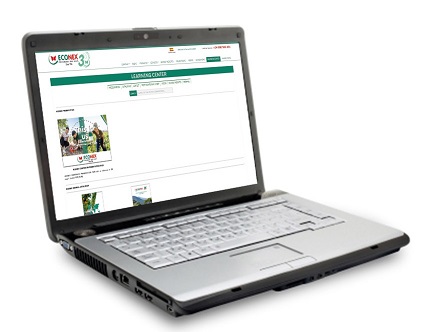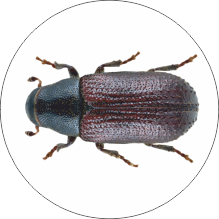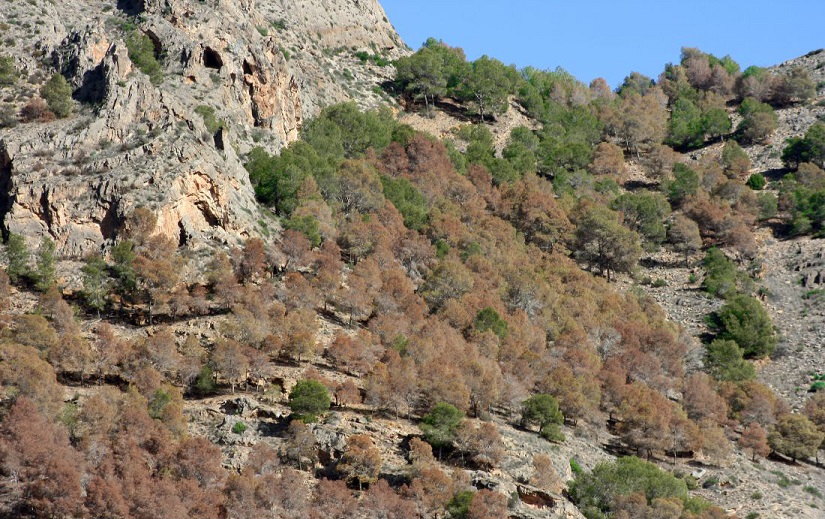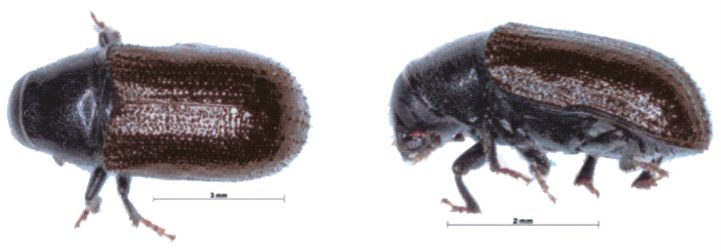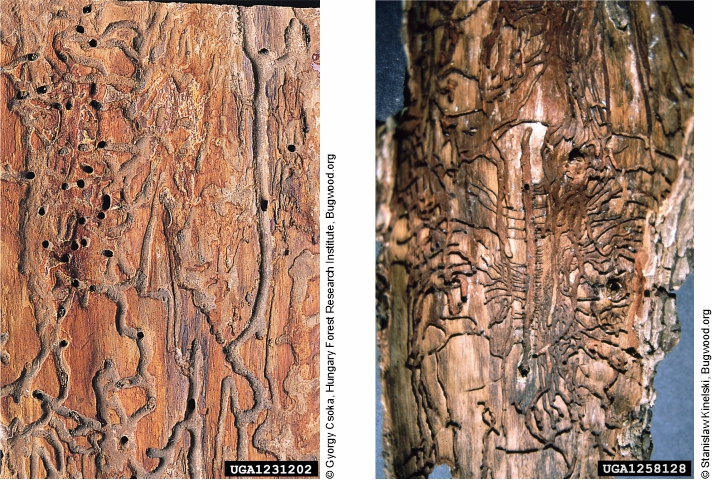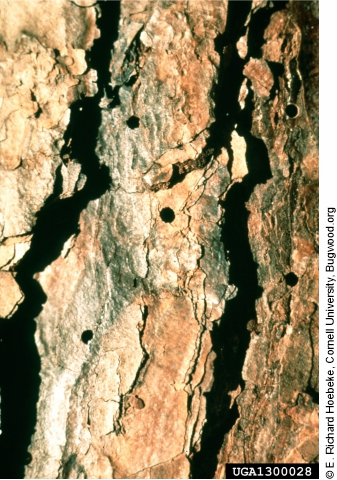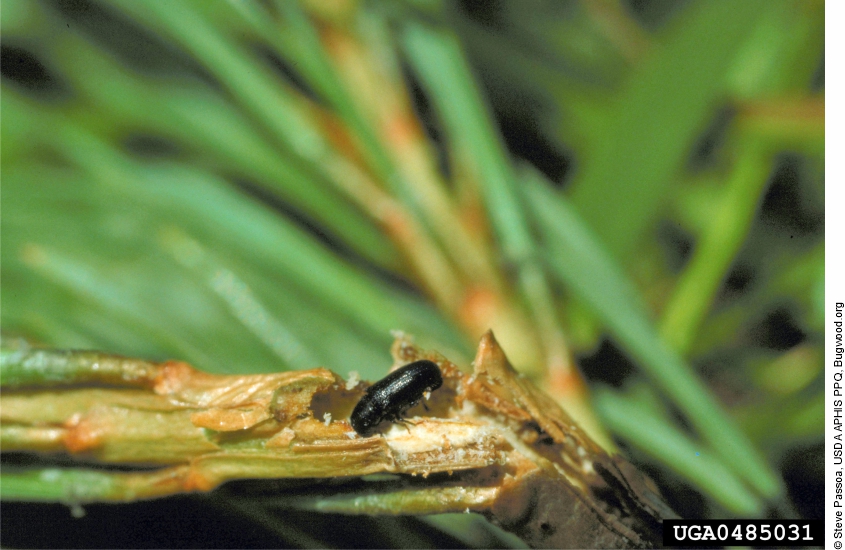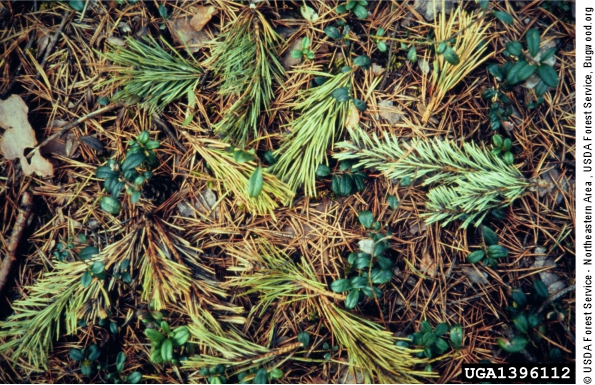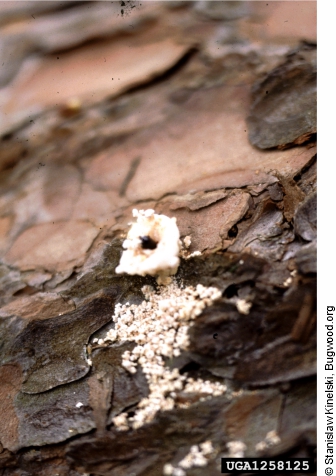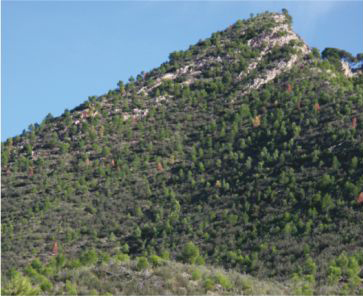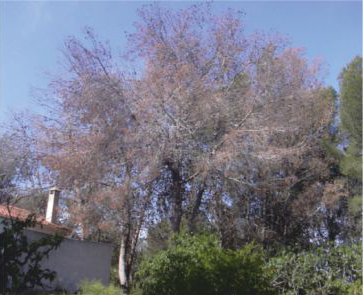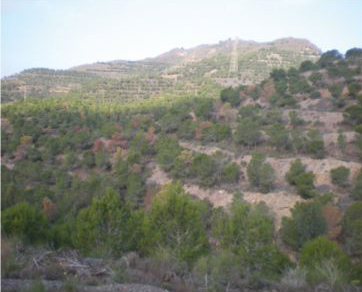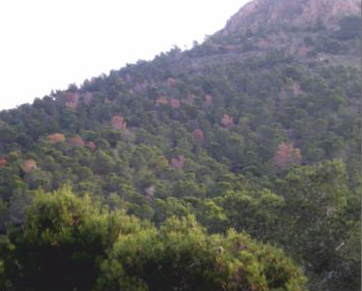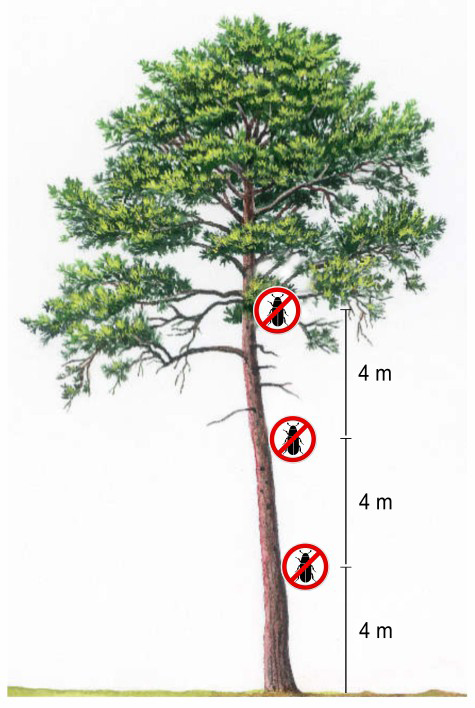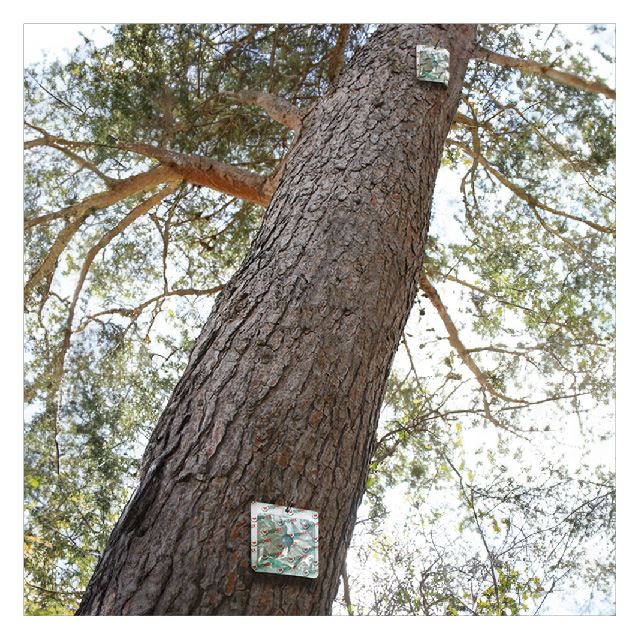Detection and monitoring
In forests 1 CROSSTRAP® MINI should be placed every 20 ha, separated at least 1000 m from each other. In surfaces less than 20 ha, at least one trap should be placed per stand or forest. The traps should be placed in areas with good visibility, such as forest borders, forest trails or fire-breaks. Windy areas should be avoided,
as the wind complicates the insects’ flight and could damage the traps. A detection trap system should cover the environmental variability of the monitored forest.
As a rule, traps should be placed and active between mid-September and mid-April. These periods of time could be shorter in years with the beginning of autumn and spring being very warm.
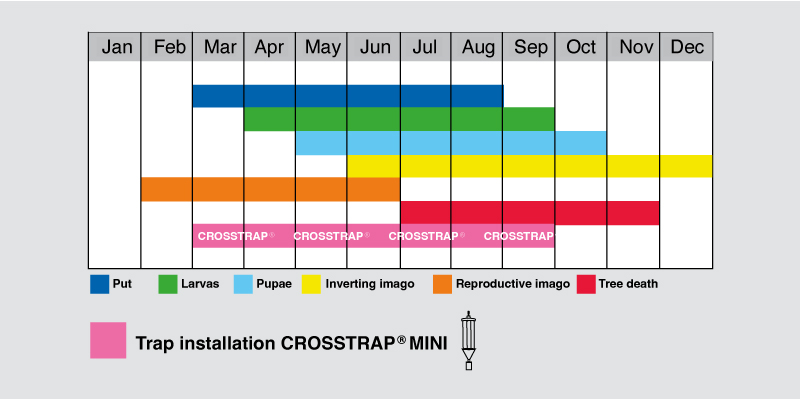
Phenology of Tomicus piniperda
For monitoring, wet captures are recommended as they allow for the precise identification of the captures. For this purpose, fill the collection cups with 10 ml of diluted propylene glycol (10 to 20%), or with antifreeze for the car. This liquid is used for killing the captured insects as well as preserving them.
It must not be dissolved too much with the rainwater, in which case it should be replaced. It is recommended to collect the captured insects at least every 15 days.
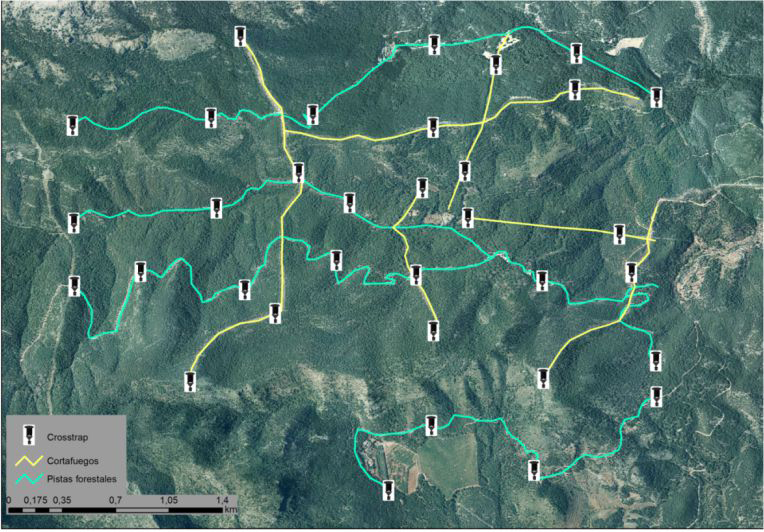
Example of installation of traps for the DETECTION AND MONITORING of T. piniperda
in a forest area of 1500 ha. 35 traps are placed following forest trails and free-breaks with a distance of 1000 m between traps
Exhaustive monitoring
In forests
For exhaustive monitoring, the traps should be placed between 100 and 500 metres apart from each other in forest trails, fire-breaks or forest borders.
This means a density of 0.3 to 3 CROSSTRAP® MINI per ha. They can also be placed inside the forest, as long as it is not too dense.
Dry captures are recommended for exhaustive monitoring using the slippery collection cup with a stainless steel mesh on the base.
The collection cup stops the bark beetles from escaping because they cannot climb out due to the slippery product, although it allows the entrance and exit of the predator Thanasimus formicarius, which devours the captured insects.
In this way, the impact of the trap system on useful fauna is minimal.

Example of installation of traps for the EXHAUSTIVE MONITORING of T. piniperda in
a forest area of 1500 ha. 55 traps are placed following forest trails and free-breaks with a distance of 500 m between traps.
In parks, gardens and residential areas
The management of Tomicus in parks and gardens presents some peculiarities that differentiate it from management in forest environments. The biggest risk of attack in ornamental trees is caused by mechanical damage.
Work involving excavation around the trees, more or less severe, destroys the roots and often causes a weakening that facilitates the attacks by Tomicus. In general, ornamental trees are not very vulnerable to attacks by Tomicus, provided that they maintain the same conditions that they grew in.
Sometimes, placing or removing irrigation systems in garden areas can provoke attacks from these insects.
The control of Tomicus in these situations must be very effective, as it is about reducing the mortality rate of the trees to zero. Therefore, efforts should be made to intensify trapping to the maximum. This means a density of 3 CROSSTRAP® MINI per ha, that should be controlled each week.
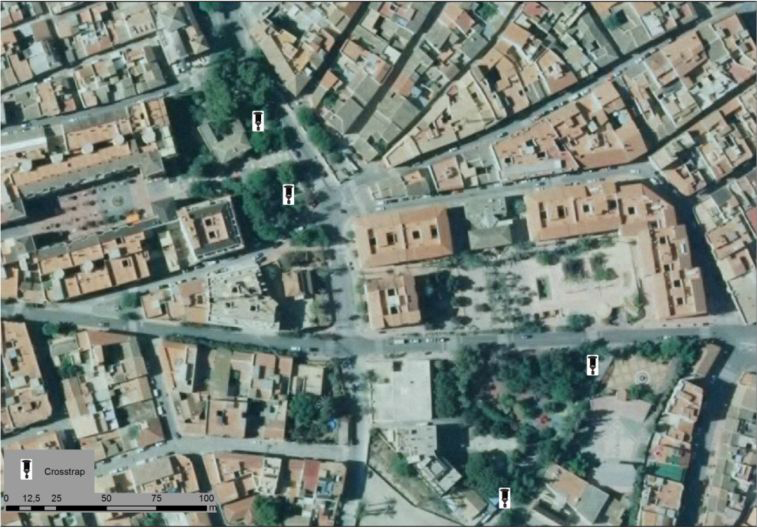
Example of installation of traps for MONITORING Tomicus piniperda,an urban area with the presence of pine trees in publics parks (0.8 ha). 4 traps are placed
in selected areas
Necessary material
To attract Tomicus piniperda, ECONEX TOMICUS PINIPERDA 60 DAYS 1 UNIT kairomone diffusers must be used, which will be hung on the CROSSTRAP® MINI trap using one of the lateral openings found on one of the sides of the trap.
ECONEX TOMICUS PINIPERDA 60 DAYS 1 UNIT consists of two diffusers of kairomonal attractant designed to attract males and females of Tomicus piniperda + 2 clip-style hangers to hang the diffusers on the trap.
The diffusers are in blister pack form, with a 60-day duration in field, and are individually packaged in aluminium sachets with a specification label. Once removed from the packs, the diffusers do not require any activation operation, nor do they need to be opened. They simply need to be properly placed in the trap.
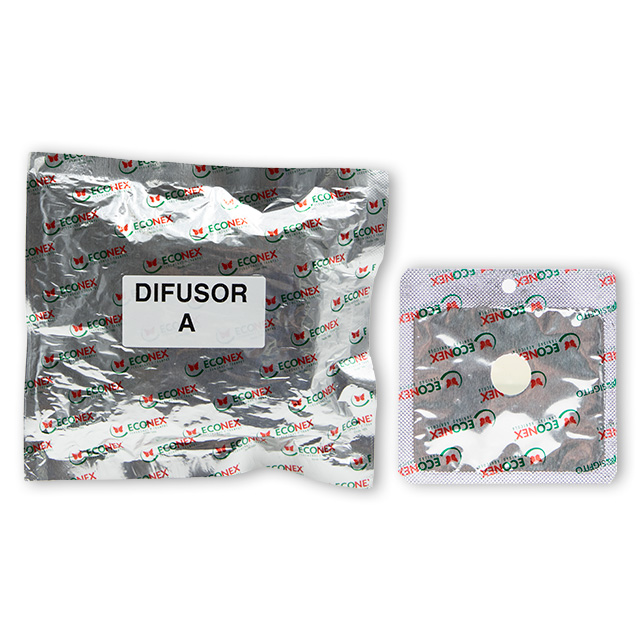
packaging and diffuser A

packaging and diffuser B
ECONEX TOMICUS PINIPERDA 60 DAYS
Kairomone diffusers for the attraction of both sexes of the species Tomicus piniperda, with a duration of 60 days in normal field conditions.
Code: UIPHOVA188
OMDF register number (Ministry of Agriculture of Spain): 149/2013

For its correct functioning, it is recommended to use it with the CROSSTRAP® MINI trap, a state-of-the-art trap to catch coleopteran insects during flight. This trap has been developed in an R&D project (University of Murcia - ECONEX) with the aim of developing traps and attractants for forest insects.
These traps consist of a polypropylene lid with a central carabiner attached to a stainless-steel spring and two reinforced PVC sheets anchored at the top to the lid by four stainless steel springs that serve as shock absorbers against strong winds, thus helping to avoid damage to the trap.
At the bottom, the reinforced PVC sheets are attached by steel springs to a removable polypropylene funnel with a 30 cm diameter. At the end of the funnel lies the container for holding the captured insects.
The sheets, the funnel and the collector are treated with a slippery product that considerably increases the catches and prevents them from escaping.
The funnel is made of polypropylene, 30 cm in diameter, and consists of two equal halves that can be easily assembled.
The trap can be operational for up to 10 years, due to its high-strength construction and components. The unfolded trap measures 33 cm in diameter by 106 cm in height.
The trap can be used with two types of collector: CROSSTRAP® WET COLLECTION CUP (with slider) 1L for wet catches, and CROSSTRAP® DRY COLLECTION CUP (with slider) for dry use or live catches.
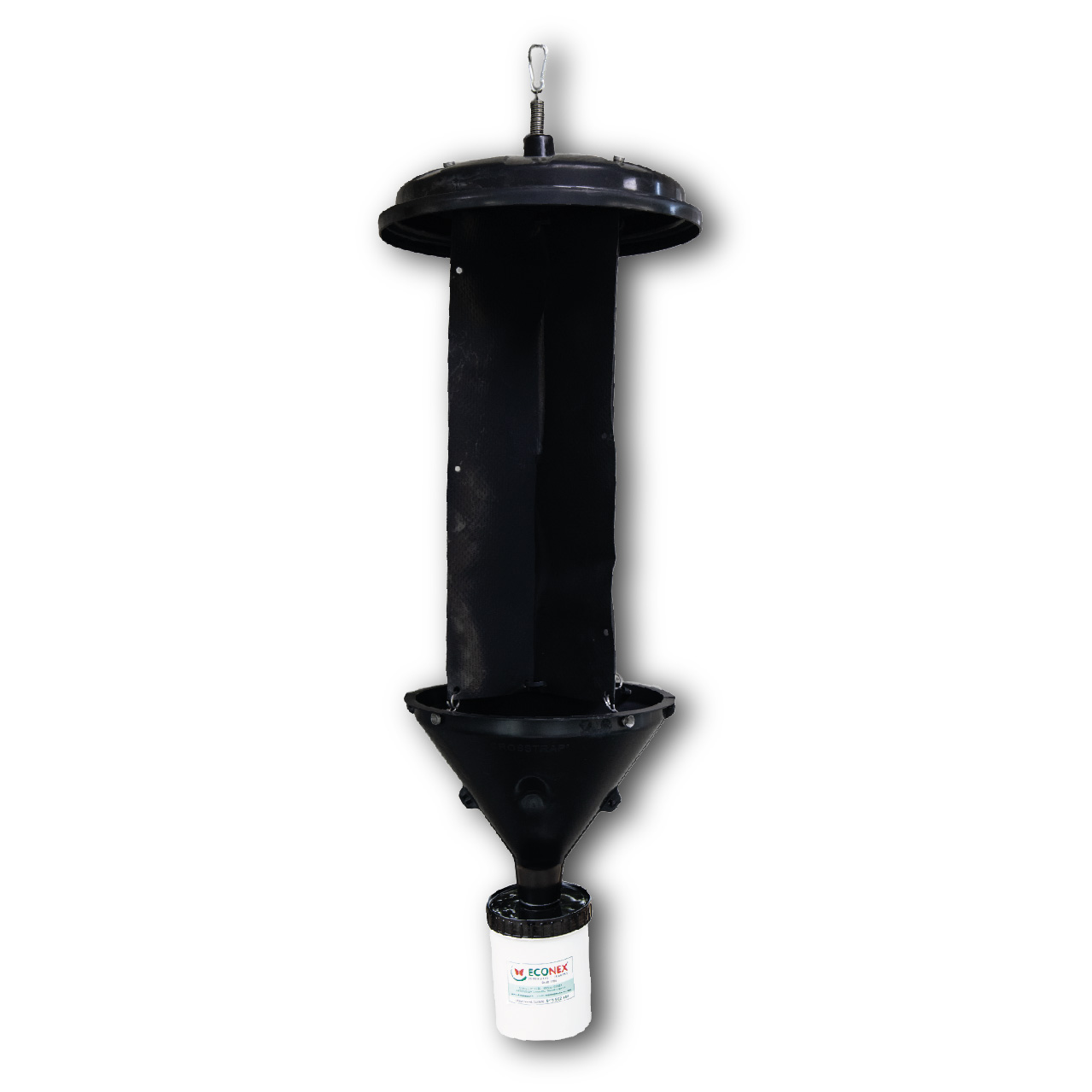
CROSSTRAP® MINI WITH WET COLLECTION CUP (with slider)
Trap for coleopteran insect interception during flight.
Code: UIPFETA226
OMDF register number (Ministry of Agriculture of Spain): 153/2013

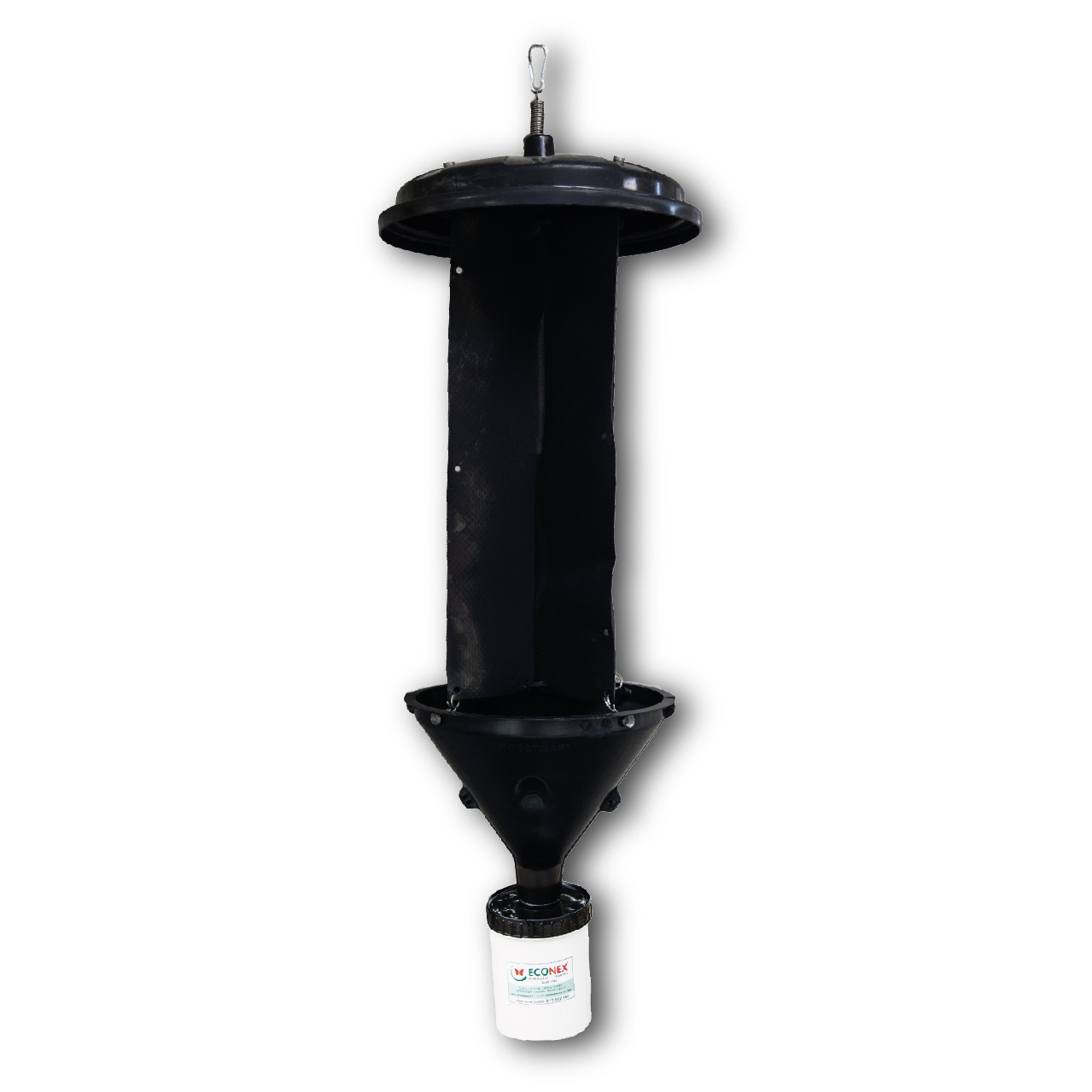
CROSSTRAP® MINI WITH DRY COLLECTION CUP (with slider)
Trap for coleopteran insect interception during flight.
Code: UIPFETA204
OMDF register number (Ministry of Agriculture of Spain): 153/2013


The CROSSTRAP® WET COLLECTION CUP (with slider) 1 L for retaining captured insects is located at the bottom of the funnel. It has a capacity of approximately 1 litre (11 cm diameter x 13.5 cm high).
The CROSSTRAP® DRY COLLECTION CUP (with slider) is designed to hold the captured insects is located at the bottom of the funnel. It has a capacity of approximately 1 litre (11 cm diameter x 13.5 cm high) and is fitted with a stainless-steel mesh at the bottom to allow rainwater to drain away.
Wet catches allow precise identification of the captures. For this purpose, it is recommended to fill the collector with 10 ml of 10 or 20 % diluted propylene glycol or, if necessary, car antifreeze. This liquid serves both as a kill agent and as a preservative, as long as it is not diluted too much by rain, in which case it should be replaced.
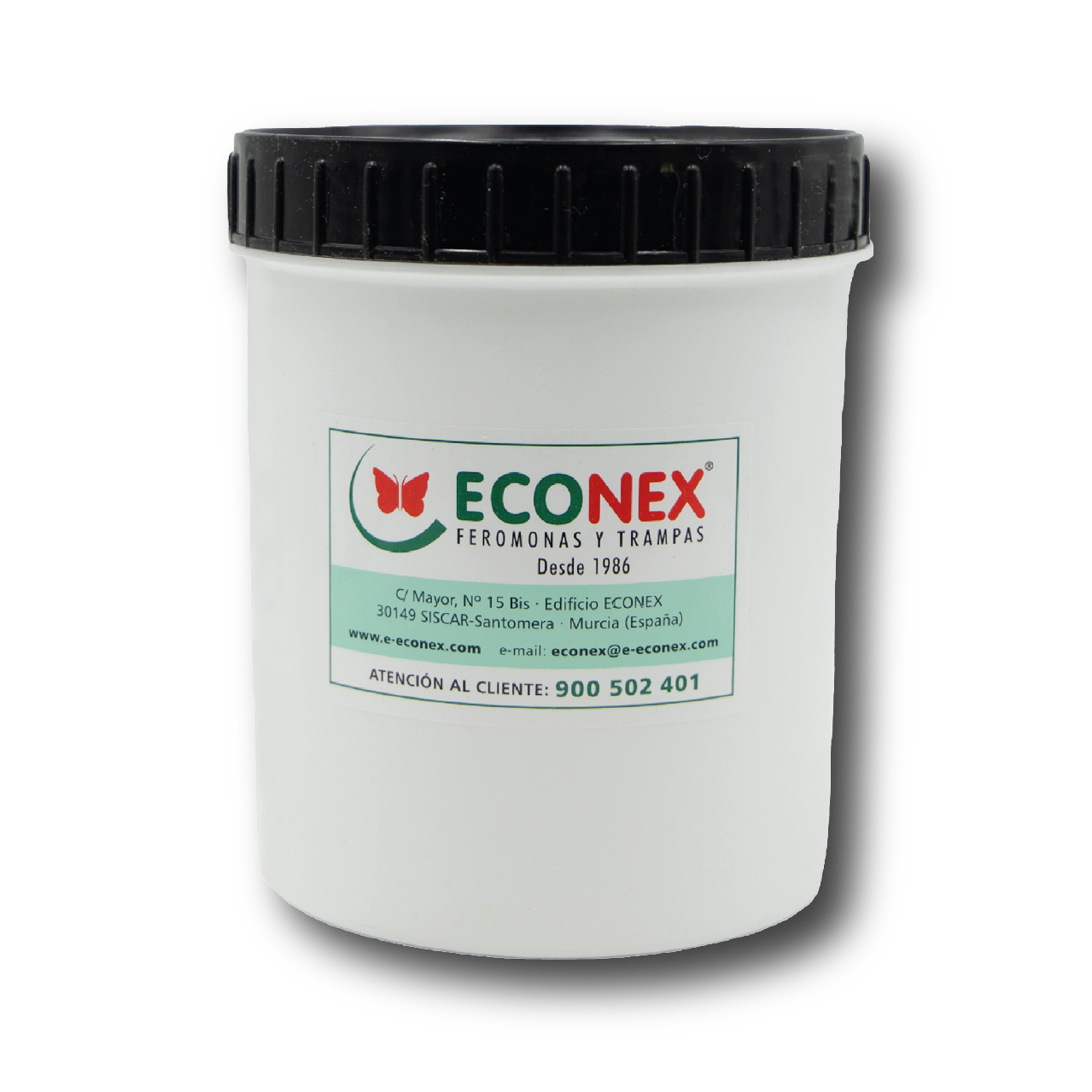
CROSSTRAP® WET COLLECTION CUP (with slider) 1 L
Wet catch collector located at the bottom of CROSSTRAP® traps.
Code: UIPFETA311


CROSSTRAP® DRY COLLECTION CUP (with slider)
Trap collector for dry use, or live traps, located at the bottom of the CROSSTRAP® traps.
Code: UIPFETA157

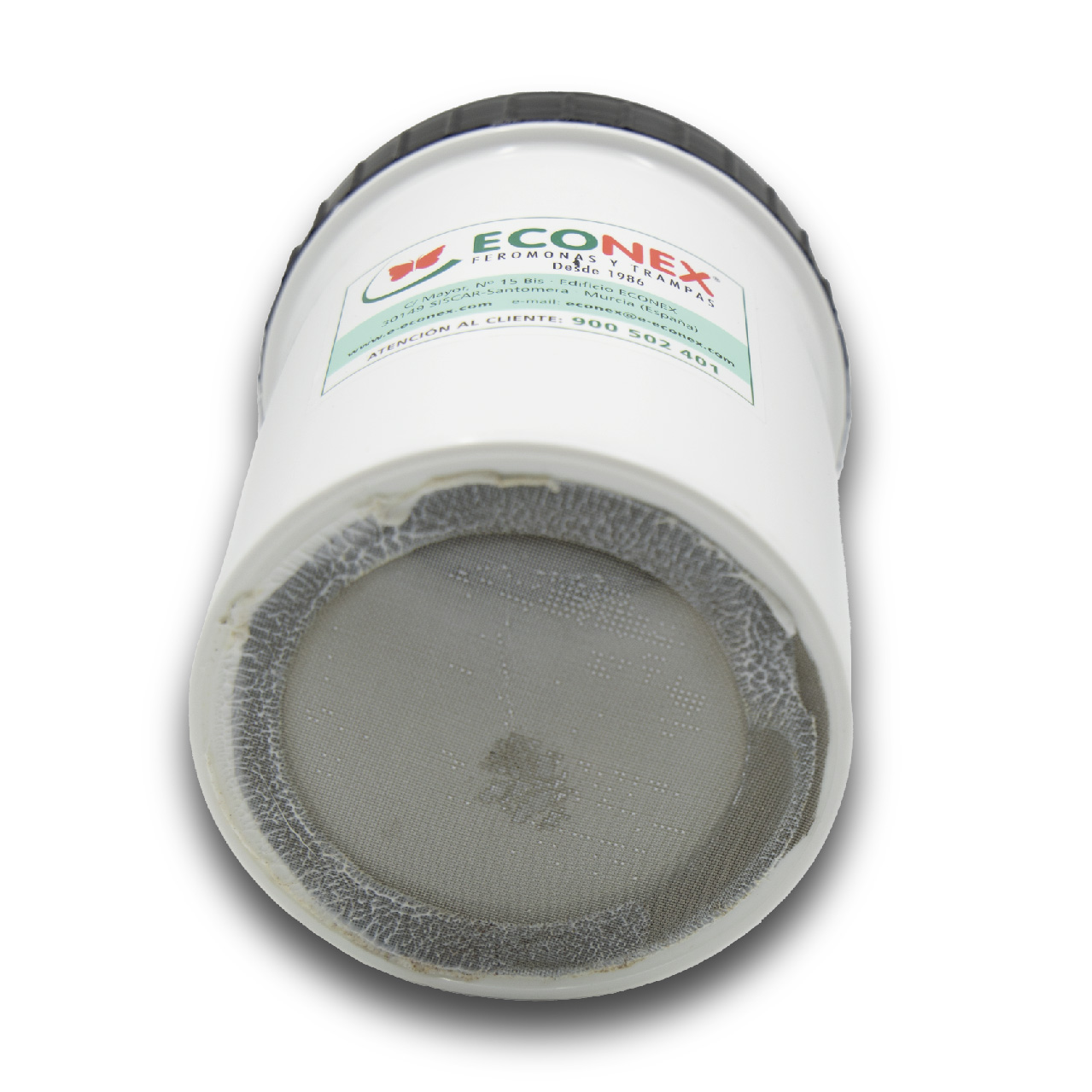
CROSSTRAP® DRY COLLECTION CUP
View from below
ECONEX TOMICUS REPELLENT 120 DAYS
To improve the biocontrol of these beetles, ECONEX has ECONEX TOMICUS REPELLENT 120 DAYS. Its use is recommended for the protection of individual pines at risk in parks, gardens or domestic outdoor gardening, as well as singular and preserved pines.
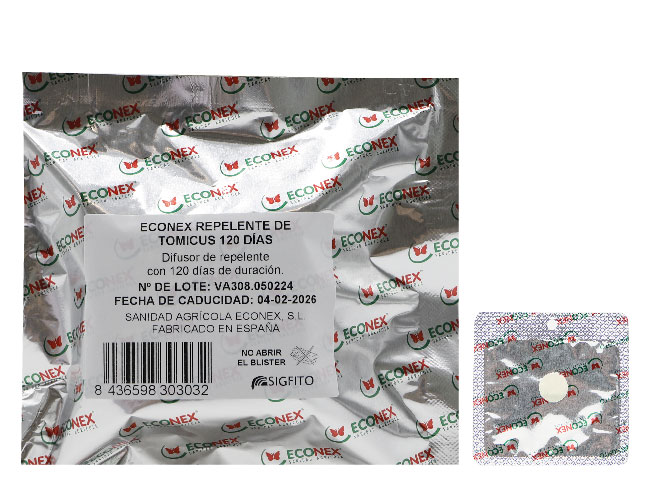
ECONEX TOMICUS REPELLENT 120 DAYS
Tomicus repellent diffuser with a duration of 120 days.
Code: UIPHOVA308

The repellent should always be used under the ‘push and pull’ strategy, using repellents and traps baited with attractants together, in such a way that the repellent pushes the Tomicus away from the pine trees, and they are attracted to the traps.
Setting up the repellent
A repellent diffuser should be placed every 4 m linearly from the trunk, up to the appearance of thin bark. Diffusers should be installed by nailing them to knots or other areas of dead pine wood.
Diagram of ECONEX TOMICUS REPELLENT 120 DAYS diffusers being installed and protecting a tree about 20 m high.
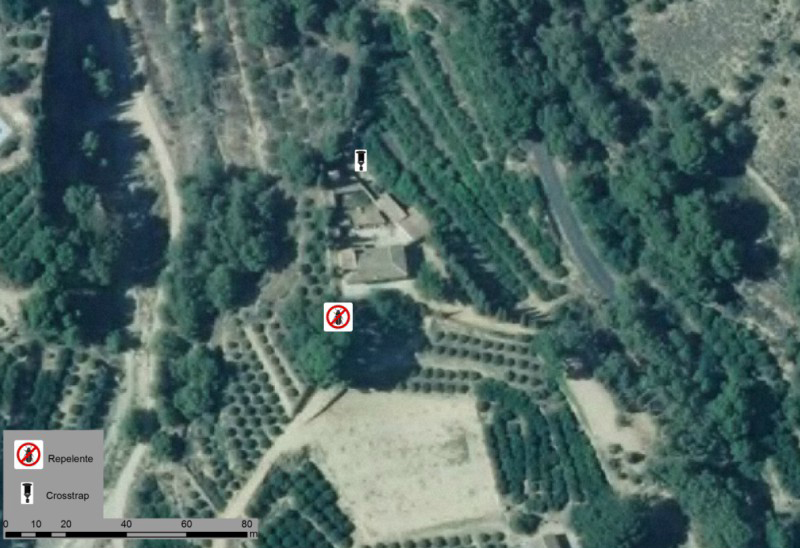
Example of installing repellents and traps to protect individual trees against Tomicus piniperda in gardens. The distance between the trap and the tree with repellents is 50 m.
Factors that influence in the number of traps needed
In forests, the number of traps is determined by the area to be covered and by the network of roads, firebreaks or accessible forest edges. For exhaustive monitoring, trap densities of between 0,1 and 0,3 CROSSTRAP® MINI traps per hectare is recommended, separated between 100 and 500 linear metres, for which we recommend the use of a GPS during installation.
In parks, gardens, recreational areas, domestic outdoor gardening or small forest areas ( <5 ha ), trap densities can be greatly increased up to 3 CROSSTRAP® MINI traps per hectare.
In these locations, the death of just one tree is shocking enough to intensify trapping, so that as many insects as possible are captured.
Storing the diffusers
The diffusers must be stored in their original packaging in a cool and dry place and separated from food and drinks.
ECONEX TOMICUS PINIPERDA 60 DAYS diffusers . 1 pc. It must be kept in its container and in the refrigerator at 4ºC or in the freezer at 18ºC, in which case they will remain valid for 90 and 150 days respectively.
ECONEX TOMICUS REPELLENT 120 DAYS must be stored in the refrigerator at 4ºC or in the freezer at 18ºC, in which case they will remain valid for 2 and 4 years respectively.
Diffuser packaging
ECONEX TOMICUS PINIPERDA 60 DAYS
Corrugated cardboard box of 100 units.
Box size: 0.40 x 0.60 x 0.35 m (length x width x height).
Box weight: 23.5 kg.
No. of boxes per pallet: 20
Pallet size: 0.80 x 1.20 x 1.95 m (length x width x height).
Pallet weight: 477 kg.
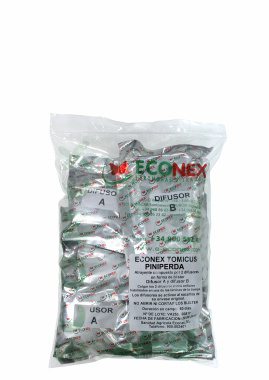
Pack of 100 units
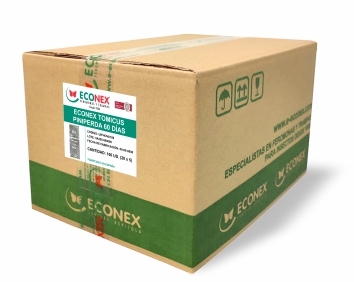
Box of 100 units.
(20 packs x 5 units)
ECONEX TOMICUS REPELLENT 120 DAYS
Corrugated cardboard box of 200 units.
Box size: 0.40 x 0.60 x 0.35 m (length x width x height).
Box weight: 17.5 kg.
No. of boxes por pallet: 20
Pallet size: 0.80 x 1.20 x 1.95 m (length x width x height).
Pallet weight: 357 kg.
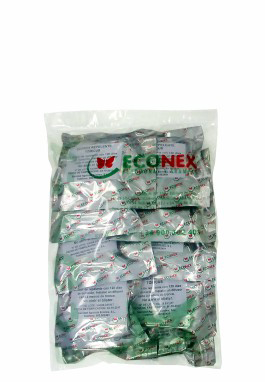
Pack of 100 units.
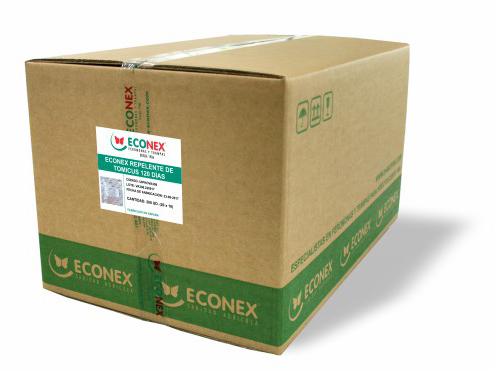
Box of 200 units.
(20 packs x 10 units)
Trap packaging
CROSSTRAP® MINI WITH WET COLLECTION CUP (with slider)
Corrugated cardboard box of 8 units.
Box size: 0.60 x 0.80 x 0.48 m (length x width x height).
Box weight: 11.30 kg.
No. of boxes por pallet: 8
Pallet size: 0.80 x 1.20 x 2.05 m (length x width x height).
Pallet weight: 100 kg.
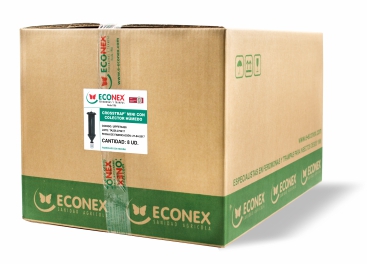
Box of 8 units.
CROSSTRAP® MINI WITH DRY COLLECTION CUP (with slider)
Corrugated cardboard box of 8 units.
Box size: 0.60 x 0.80 x 0.48 m (length x width x height).
Box weight: 11.30 kg.
No. of boxes por pallet: 8
Pallet size: 0.80 x 1.20 x 2.05 m (length x width x height).
Pallet weight: 100 kg.
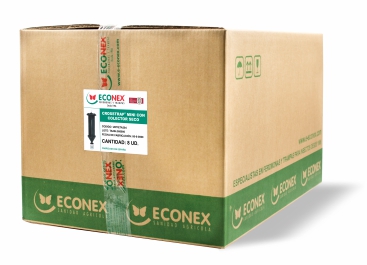
Box of 8 units.
Recommended information:
ECONEX CATALOGUE OF PRODUCTS AND SERVICES FOR FOREST PESTS
Catalogue in PDF format with 94 pages. An essential reference book about the biological behaviours of the main forest insect populations. It also includes solutions from ECONEX to solve the problems caused by these insects through the use of traps and specific attractants.
Download the catalogue by clicking on the image.

ECONEX PRODUCTS AND SERVICES FOR FOREST PESTS LEAFLET
The leaflet can be downloaded in PDF format by clicking on the image.

ECONEX TOMICUS REPELLENT 120 DAYS. “Push – pull” strategy”
The leaflet can be downloaded in PDF format by clicking on the image.

ECONEX GREEN AREAS LEAFLET
Leaflet in PDF format that can be downloaded by clicking on the image.

www.greenareas.e-econex.eu

ECONEX LEARNING CENTER
ECONEX puts at your disposal the first open knowledge center that brings together everything necessary to implement pest biocontrol in your crops. We have developed different types of resources to share with you the knowledge we have acquired during our more than 38 years of experience. Each of them is designed to respond, in the best possible way, to different questions related to pheromones, attractants, repellents and insect traps.
To access ECONEX LEARNING CENTER click on the image.
